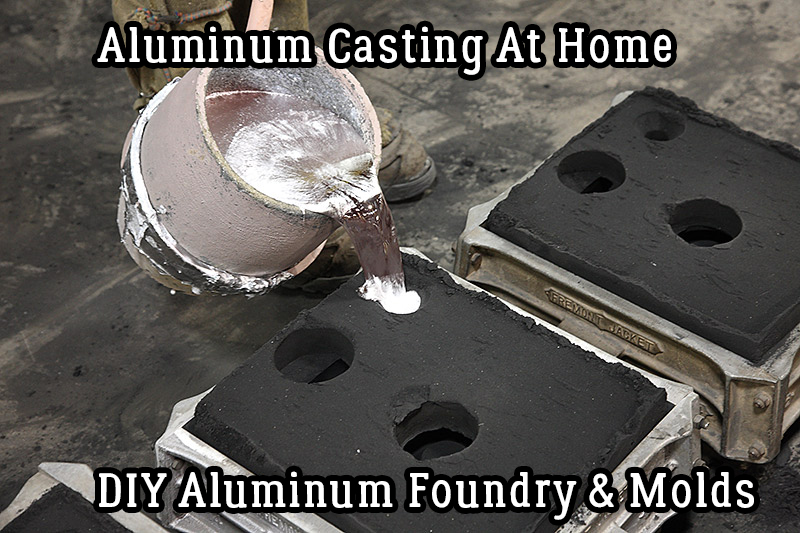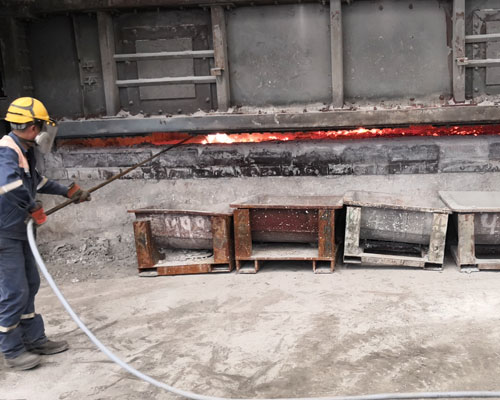Aluminum Foundry offers durable results in aluminum casting for businesses
Wiki Article
Recognizing the Various Kinds of Processes in An Aluminum Foundry for Effective Production
In An Aluminum Foundry, numerous casting processes play an essential duty in manufacturing efficiency. Each approach, from sand spreading to die spreading, uses unique advantages that accommodate certain making needs. Recognizing these processes is crucial for enhancing quality and expense. The selection of casting technique can considerably affect overall result. As foundries discover these alternatives, they should consider which techniques align finest with their manufacturing objectives. What variables will ultimately lead their decisions?Review of Aluminum Foundry Processes
Aluminum Foundry processes incorporate a series of specialized methods intended at transforming raw Aluminum right into useful components. These processes typically begin with thawing the Aluminum, where main or scrap Aluminum is warmed until it reaches a liquified state. Once melted, the Aluminum might undergo alloying, where certain components are added to enhance its residential or commercial properties, such as strength or corrosion resistance.Complying with melting and alloying, the Aluminum is put right into mold and mildews to produce preferred forms. Air conditioning and solidification occur, during which the material handles the type of the mold. After solidification, castings are gotten rid of and might call for more handling, consisting of cutting, machining, or surface area therapy to attain the final requirements. Quality assurance is important throughout the process, ensuring that the produced elements meet industry standards. In general, Aluminum Foundry processes are vital for creating a wide variety of light-weight and long lasting items used in various applications.
Sand Casting Strategies
A significant section of Aluminum castings are produced utilizing sand casting techniques, which is a functional technique favored for its capacity to produce intricate forms. In this process, a mold is made from sand combined with a binding agent, ensuring it can withstand the liquified Aluminum's temperature level. The pattern, normally made from metal or plastic, is positioned in the sand to develop the cavity for the spreading. After getting rid of the pattern, the mold is full of molten Aluminum, which strengthens into the desired form upon air conditioning.Sand spreading is especially beneficial for reduced to medium manufacturing volumes because of its cost-effectiveness and adaptability. In addition, it permits very easy adjustments of mold and mildew styles, suiting various part geometries. Though it might not attain the dimensional accuracy of other casting approaches, the surface area finish can be enhanced via subsequent machining. In general, sand spreading stays a keystone of Aluminum Foundry processes, making certain diverse applications across sectors.
Die Spreading Methods
In the domain name of die spreading methods, 2 primary processes attract attention: the warm chamber and chilly chamber strategies. Each method provides one-of-a-kind advantages and difficulties, particularly relating to performance and material compatibility. Additionally, the choice of die products plays a crucial role in figuring out the general success and durability of the casting process.Hot Chamber Process

Cold Chamber Process
Cold chamber pass away casting represents an alternate method for generating Aluminum elements, particularly when dealing with steels that have higher melting factors or when the molten metal is also reactive for warm chamber procedures. In this method, liquified Aluminum is poured right into the die from an outside ladle, which decreases the risk of contamination and enables for better adaptability in alloy option. The procedure includes infusing the molten metal into a cool die making use of a hydraulic piston, guaranteeing exact control over the shot rate and stress. This method is helpful for creating intricate geometries and accomplishing high dimensional precision. It may require longer cycle times compared to warm chamber procedures, cool chamber pass away casting is vital for certain applications in Aluminum factories.Pass Away Products Choice
Picking the proper die products is essential for maximizing the die casting procedure and making certain the longevity and performance of the molds. One of the most generally utilized products consist of tool Aluminum, steel, and beryllium-copper alloys, each offering distinct advantages. Device steel is favored for its sturdiness and resistance to use, making it perfect for high-volume production runs. Aluminum offers superb thermal conductivity, facilitating reliable heat dissipation, while beryllium-copper alloys integrate stamina and thermal management residential or commercial properties, though at a greater price. Variables affecting the choice include the complexity of the part, anticipated manufacturing volume, and the details Aluminum alloys being cast. Eventually, the best option of die material can considerably boost productivity and lower total operational expenses in Aluminum foundries.Financial Investment Casting Procedures
While numerous casting approaches exist, financial investment casting sticks out for its ability to create complex shapes with high accuracy and excellent surface area coatings. This procedure includes creating a wax pattern that is covered with a ceramic covering. As soon as the covering hardens, the wax is dissolved, leaving a dental caries that is filled up with molten Aluminum.Financial investment casting is specifically useful for producing intricate geometries that would be tough or difficult to accomplish with other approaches. It allows for limited tolerances, minimizing the requirement for comprehensive machining post-casting. In addition, the smooth surface area coating lessens the demand for secondary procedures, consequently improving effectiveness.
This strategy is extensively made use of in markets needing comprehensive components, such as aerospace and clinical industries. The flexibility of investment casting makes it possible for the manufacturing of both small and big amounts, making it a useful alternative in Aluminum foundries looking for to satisfy diverse production demands.
Permanent Mold Casting
Permanent mold casting is an approach that employs reusable mold and mildews to create Aluminum components, enhancing efficiency in manufacturing. This technique offers numerous advantages, including enhanced dimensional accuracy and surface finish, making it appropriate for numerous industrial applications. By recognizing its procedure, benefits, and makes use of, one can value its value in the Aluminum Foundry industry.Process Introduction
Aluminum Foundry processes encompass various techniques, one of which is permanent mold and mildew casting. This technique uses multiple-use mold and mildews, usually made from steel, permitting efficient production of Aluminum parts. The process starts with preheating the mold and mildew to boost fluidness and lower flaws. Molten Aluminum is after that put into the mold and mildew under gravity or stress, ensuring precise filling and reducing air entrapment. Once the Aluminum cools down and strengthens, the mold is opened up to obtain the cast component. Permanent mold and mildew spreading is known for producing top quality, dimensionally exact parts appropriate for various applications. The strategy is particularly useful for high-volume production runs, as it significantly reduces product waste and enhances repeatability in producing procedures.Benefits of Method
Although different casting approaches exist, irreversible mold and mildew casting supplies unique advantages that make it a recommended choice for several manufacturers. This technique enables superior dimensional accuracy and surface finish, lowering the need for substantial machining. The reusable mold and mildews, commonly made from steel, boost production performance by allowing for rapid cycle times and lower general product prices. Furthermore, permanent mold and mildew spreading promotes improved mechanical properties in the end product as a result of the controlled cooling prices, which result in finer grain frameworks. Furthermore, as the procedure creates much less waste compared to sand spreading, it is a lot more eco-friendly. Overall, these benefits contribute to cost-effectiveness and top notch results, making irreversible mold casting a calculated option in the Aluminum Foundry industry.
Applications in Industry
In different fields, permanent mold casting plays a vital function in creating premium Aluminum components, particularly where precision and resilience are vital - Aluminum Foundry. This technique is commonly made use of in the vehicle industry for producing engine blocks, transmission housings, and other vital parts that need specific tolerances and robust performance. In addition, the aerospace sector take advantage of long-term mold casting for elements that must withstand extreme conditions while maintaining light-weight attributes. In addition, durable goods typically use this strategy for generating durable and visually pleasing things, such as cookware and decorative components. The ability to achieve complicated geometries and great surface coatings makes long-term mold casting a recommended selection throughout diverse applications, making certain reliable and dependable manufacturing in numerous industrial contextsMachining and Finishing Operations
Accuracy machining and finishing operations play a necessary role in the Aluminum Foundry procedure, guaranteeing that cast elements meet strict high quality and dimensional specifications. These procedures involve various methods, such as milling, transforming, drilling, and grinding, which are made use of to fine-tune the surfaces of cast parts. Each method is picked based on the details requirements of the part, including its size, form, and designated application.Finishing processes, such as anodizing and surface area sprucing up, improve the visual appeal and deterioration resistance of Aluminum components. Additionally, these procedures assist accomplish tighter resistances and smoother surfaces, which are critical for performance in numerous commercial applications.
Quality Assurance in Aluminum Foundries
Quality assurance in Aluminum shops is a crucial element that assures the stability and performance of actors items. This process includes methodical evaluations and screening at different phases of production. Shops carry out strenuous quality checks, including aesthetic assessments, dimensional dimensions, and material analysis, to ascertain that every actors fulfills defined standards.Additionally, progressed methods such as non-destructive testing (NDT) are employed to discover internal flaws that might not be visible externally. By keeping track of variables like temperature and alloy structure, factories can maintain perfect manufacturing problems, lowering the chance of issues.
Adherence to sector requirements, such as ISO certifications, enhances a foundry's commitment to top quality. Constant training and development of workers additionally play a critical function in promoting a culture of quality recognition. Ultimately, effective quality assurance methods improve customer contentment and minimize costly rework and scrap, guaranteeing the Foundry's competitive side in the market.
Regularly Asked Questions

What Precaution Are Needed in An Aluminum Foundry?
Safety procedures in An Aluminum Foundry include correct personal safety tools, ventilation systems to take care of fumes, fire avoidance protocols, normal tools maintenance, employee training on risks, and emergency action plans to deal with prospective accidents effectively.Just How Does Recycling Aluminum Affect Foundry Processes?
Reusing Aluminum considerably impacts Foundry procedures by reducing resources prices, decreasing waste, and reducing power intake. This environment-friendly method improves manufacturing efficiency while promoting sustainability, eventually profiting both the Aluminum and the setting market.What Are the Environmental Influences of Aluminum Foundries?
The ecological influences of Aluminum foundries include air and water contamination, high energy consumption, and significant greenhouse gas exhausts. These elements contribute to habitat destruction and wellness dangers for surrounding neighborhoods, demanding boosted sustainability techniques.Exactly How Do Shops Handle Waste and Emissions?
Foundries manage waste and discharges with numerous techniques, including recycling scrap steel, executing purification systems, and adhering to environmental Aluminum Foundry policies. These procedures aim to decrease environmental impact while keeping operational efficiency and performance.What Is the Duty of Automation in Aluminum Foundries?
Automation in Aluminum factories enhances performance and accuracy. It lessens human error, enhances production procedures, and reduces labor expenses. By incorporating sophisticated technology, shops can boost item quality and assurance regular operational performance.Aluminum Foundry processes incorporate a series of specialized methods intended at transforming raw Aluminum right into functional parts. These processes typically start with melting the Aluminum, where primary or scrap Aluminum is warmed until it gets to a molten state. The hot chamber process is a highly effective die spreading approach generally used for Aluminum alloys. Cold chamber die spreading stands for an alternate technique for creating Aluminum elements, especially when dealing with metals that have higher melting points or when the molten metal is as well reactive for hot chamber procedures. Aluminum Foundry. Aluminum Foundry procedures encompass various techniques, one of which is permanent mold spreading
Report this wiki page